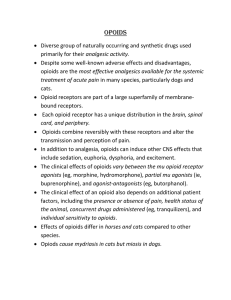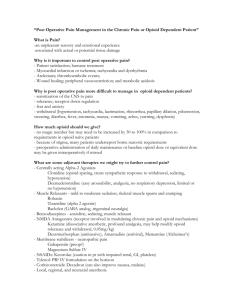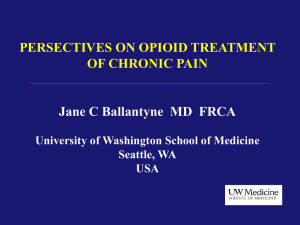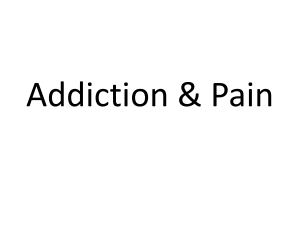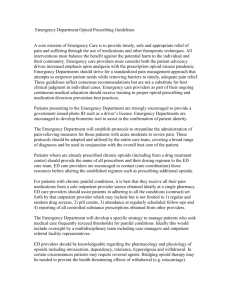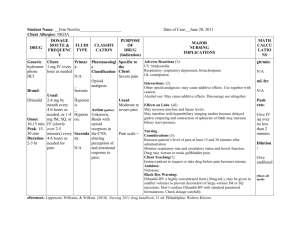Guideline for Safe Chronic Opioid Therapy Prescribing For Patients
advertisement
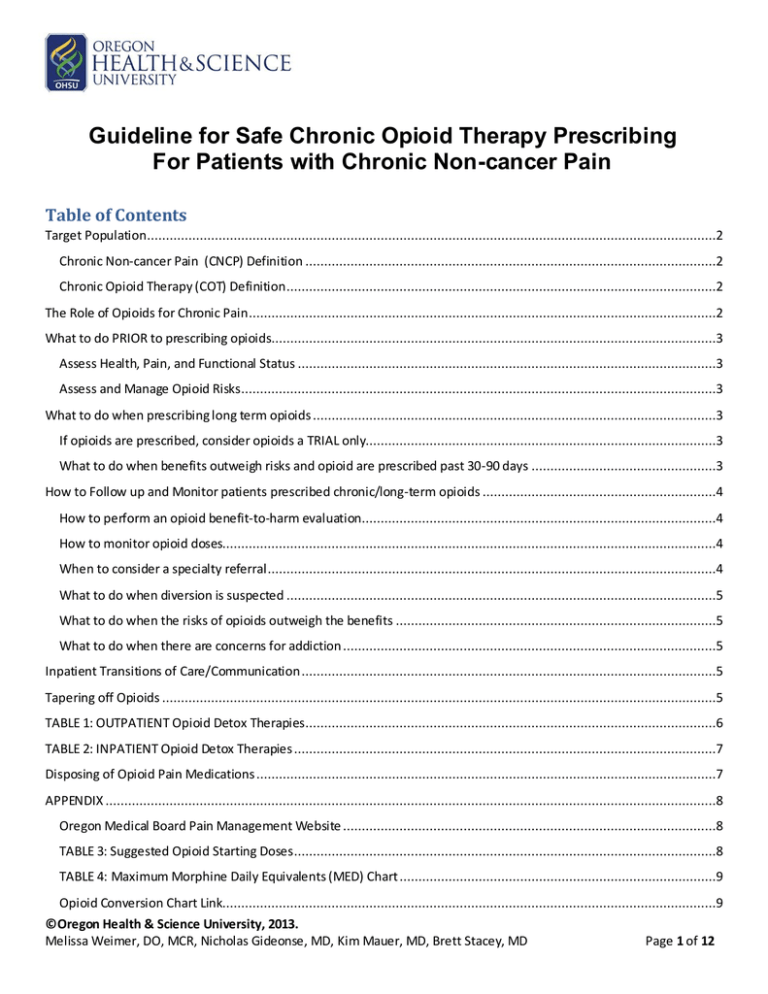
Guideline for Safe Chronic Opioid Therapy Prescribing For Patients with Chronic Non-cancer Pain Table of Contents Target Population.......................................................................................................................................................2 Chronic Non-cancer Pain (CNCP) Definition .............................................................................................................2 Chronic Opioid Therapy (COT) Definition ..................................................................................................................2 The Role of Opioids for Chronic Pain ............................................................................................................................2 What to do PRIOR to prescribing opioids......................................................................................................................3 Assess Health, Pain, and Functional Status ...............................................................................................................3 Assess and Manage Opioid Risks ..............................................................................................................................3 What to do when prescribing long term opioids ...........................................................................................................3 If opioids are prescribed, consider opioids a TRIAL only.............................................................................................3 What to do when benefits outweigh risks and opioid are prescribed past 30-90 days .................................................3 How to Follow up and Monitor patients prescribed chronic/long-term opioids ..............................................................4 How to perform an opioid benefit-to-harm evaluation..............................................................................................4 How to monitor opioid doses...................................................................................................................................4 When to consider a specialty referral .......................................................................................................................4 What to do when diversion is suspected ..................................................................................................................5 What to do when the risks of opioids outweigh the benefits .....................................................................................5 What to do when there are concerns for addiction ...................................................................................................5 Inpatient Transitions of Care/Communication ..............................................................................................................5 Tapering off Opioids ...................................................................................................................................................5 TABLE 1: OUTPATIENT Opioid Detox Therapies .............................................................................................................6 TABLE 2: INPATIENT Opioid Detox Therapies ................................................................................................................7 Disposing of Opioid Pain Medications ..........................................................................................................................7 APPENDIX ..................................................................................................................................................................8 Oregon Medical Board Pain Management Website ...................................................................................................8 TABLE 3: Suggested Opioid Starting Doses ................................................................................................................8 TABLE 4: Maximum Morphine Daily Equivalents (MED) Chart ....................................................................................9 Opioid Conversion Chart Link...................................................................................................................................9 ©Oregon Health & Science University, 2013. Melissa Weimer, DO, MCR, Nicholas Gideonse, MD, Kim Mauer, MD, Brett Stacey, MD Page 1 of 12 Examples of how to calculate Morphine Equivalent per Day (MED)............................................................................9 TABLE 5: Patterns that Suggest Addiction versus Therapeutic Use............................................................................10 Sample Patient Opioid Handout.............................................................................................................................10 Opioid Side Effects................................................................................................................................................10 Opioid Detox Instructions for patients....................................................................................................................11 TABLE 6: Portland Area Substance Abuse Treatment Centers ..................................................................................11 Target Population The recommendations in this guideline apply to patients with chronic non -cancer pain (CNCP) who are prescribed chronic, or long term, opioid therapy (COT). Most recommendations apply to the outpatient setting, but some have particular relevance to the inpatient setting. Exceptions: Hospice and/or end of life Canc er-related pain Children under the age of 18 Acute pain (<90 days) Chronic Non-cancer Pain (CNCP) Definition Pain that extends beyond the expected duration of healing, or 3 months. Chronic Opioid Therapy (COT) Definition The use of any prescribed long-acting opioid medication or daily (or near daily) use of a prescribed short-acting opioid for 90 days or more. The Role of Opioids for Chronic Pain Patients with chronic non-cancer pain (CNCP) have a right to medically appropriate, evidence-based treatment. Treatment must be individualized based on a comprehensive medical and psycho -social assessment of the patient. Clinicians (physicians, NPs, and PAs) have the responsibility to diagnose and manage chronic pain with the goals of: 1) Optimizing the patient’s functioning, sense of well -being, and safety. 2) Minimizing potential adverse effects of treatment. These include adverse effects on the individu al patient as well as adverse effects on others (e.g., through diversion of prescribed medications to others). CNCP is often a complex, bio-psychosocial condition that responds best to a multimodal treatment approach emphasizing active patient self-management and includes psychotherapeutic interventions, functional restoration, interdisciplinary rehabilitation, medication therapies, and alternative and complementary treatments. Multiple medications, both non-opioid and opioid, are effective for the treatment of CNCP. It is recommended that non-opioid medications be considered first for the treatment of CNCP. The expected improvement of pain with opioids is only 20-30%. Some patients do not respond to opioids and opioids have significant risks and side effects. If opioids are started, the following guidelines are recommended. The following guideline attempts to provide a framework for safe and effective long term opioid management. Please also see the previously published Clinical Guidelines for the Use of Chronic Opioid Therapy in Chronic Noncancer pain and the Washington State Opioid Dosing Guideline. ©Oregon Health & Science University, 2013. Melissa Weimer, DO, MCR, Nicholas Gideonse, MD, Kim Mauer, MD, Brett Stacey, MD Page 2 of 12 What to do PRIOR to prescribing opioids Assess Health, Pain, and Functional Status a. b. c. d. e. f. g. Obtain a pain history. i. The Brief Pain Inventory (S hort Form) will help with this history Perform a complete physical exam including evaluation of the neurologic and musculoskeletal systems E valuate mental health and substance abuse history E valuate for reversible causes of pain and work up as appropriate E valuate functional status by (at minimum) asking the following question i. In the last mont h, how much has pain interfered with your daily activities ? Use a scale from 0 to 10, where 0 is “no interference” and 10 is “unable to carry on any activities.” Render a specific diagnosis i. The problem for which opioids are being considered should be clearly defined in the OHSU Epic Problem List (“Chronic Pain” is not a diagnosis and “low back pain” is not very specific). Consider non-medication and non-opioid pain treatment modalities Assess and Manage Opioid Risks a. b. c. d. e. f. g. h. Risks of opioids include substance abuse, mental health disorder, falls, overdose, diversion. See other risks Check the Oregon Prescription Drug Monitoring Database (an online controlled substance database) Obtain a urine drug test (OHSU Lab 0066) Perform a benefit-to-harm evaluation using the following tools i. Review prior PCP and specialist records ii. Review medication list iii. Take a substance abuse history - consider using the A UDIT or DAS T questionnaires iv. Screen for depression using a PHQ-2 or P HQ-9 Depression questionnaires 1. Patients with PHQ 9 scores >15 are risky candidates for COT v. Assess opioid risk with the Opioid Risk Tool (ORT) 1. Can be accessed in Epic under smartlists or docflowsheets “opioidrisktool” 2. Patients with ORT scores >7 (high) are risky candidates for COT vi. Obtain a baseline ECG in patients considered for met hadone pain treatment 1. Carefully evaluate and reconsider methadone prescription if patient has QTc > 450ms vii. Assess for conditions that can be worsened by opioids Opioids should not be prescribed for patients with active substance abuse except in the context of a clearly documented treatment plan developed jointly and agreed to by the patient, prescribing clinician, and substance abuse provider. Opioids should be cautiously started in patients with mental illness. Closely coordinate behavioral health care for patients who have both mental illness and chronic pain. Refer for behavioral health care if needed. The community standard is evolving against co-prescription with other psychoactive drugs wit h potential for abuse. Thes e include medical marijuana, benzodiazepines, and other sedative-hypnotics. Advise against the use of these with concomitant opioids. viii. Benzodiazepines in particular have been reported in a high proportion of overdose deaths. Opioids should not be prescribed to patients on Methadone Maintenance Therapy or Subox one (buprenorphine) without first conferring wit h the addiction provider. What to do when prescribing long term opioids If opioids are prescribed, consider opioids a TRIAL only a. b. Clinicians should initiate opioid therapy at low doses (See Table 3). The dose should not be increased if incremental pain relief or functional improvement is not achieved. If after 30-90 days on opioids, the patient does not exhibit improvement in his or her function or activity, it is recommended that opioids be discontinued or a specialty pain referral be placed. What to do when benefits outweigh risks and opioid are prescribed past 30-90 days a. Obtain a urine drug test if not already done to assess for both unexpected drugs of abus e or coprescribing, and presence of the prescribed opioid ©Oregon Health & Science University, 2013. Melissa Weimer, DO, MCR, Nicholas Gideonse, MD, Kim Mauer, MD, Brett Stacey, MD Page 3 of 12 b. c. d. e. f. g. h. i. Always clarify with the patient and other providers which clinician holds primary responsibility for prescribing; CNCP patients should rec eive chronic pain management from one clinician only. Indicate in the OHSU Epic Problem List under the specific diagnosis who is responsible for opioid prescriptions. OHS U Ambulat ory Provider: Use the following smart phrase to document current opioid prescribing plan in the OHS U Epic Problem List : “.OpioidTreatmentSummary ” Sign an opioi d agreement with the patient. This is an explicit agreement bet ween prescriber and patient. A generic OHS U Opioid Agreement can be found here. i. Once signed, Opioid Agreements can be found under the “Media” tab, “Controlled Substance Agreement” filter, or by typing into Epic “.csagreement” Under Oregon Medical Board rules, informed consent must be documented in a Written Notice Disclosing the Material Risk s Associated with Prescribed or Administered Controlled S ubstances for the Treatment of the Intractable Pain. Ask the patient to provide a statement of specific, measurable, time bound, and realistic treatment goals i. Consider tracking goals with an Activity Diary Prescribe the lowest effective opioid dose for the problem and ensure not to exceed recommended maximum morphine equivalent (MED) dos e in a 24 hour period. i. NOTE: It i s recommended not to exceed 120mg total MED or 60mg of methadone in a 24 hour period without consultation of the specialty pain service. ii. In order to calculate and document the total morphine equivalent dose (ME D) an electronic MED calculator is available at http://www.agencymeddirectors.wa.gov/Files/DosingCalc.xls iii. See Table 4 for a demonstration of maximum rec ommended dos e per opioid agent bas ed on morphine equivalency. iv. It is also important to note that MED is a good way to compare opioid agents. However, MED i s not be used for dosi ng conversion between different opioid agents. v. Calculat e and document the total acetaminophen dose, including prescribed and over -the counter Arrange follow up with the patient, at minimum every 3 months How to Follow up and Monitor patients prescribed chronic/long-term opioids How to perform an opioid benefit-to-harm evaluation a. b. c. d. e. This should be performed and documented periodically (standard of care is usually every 3 months) i. Includes a physical, functional assessment, pain assessment, and mental health assessment Access the Oregon Prescription Drug Monitoring Database, at least every 6 months to assess patient’s controlled substance prescribing history Obtain urine drug testing every 6 months – 1 year (OHS U Lab 0066) i. A reminder can be placed in the health maintenance tab in Epic (urine toxicology testing) Assess for aberrant drug related behavior (see Table 5) Periodically discuss risks of opioids with patients How to monitor opioid doses a. b. c. Do not exceed 120mg of MED or 60mg of methadone in a 24 hour period (See Table 4) If analgesia is not obtained at the above doses, consider specialty referral If COT prescribed > 6 months, in general, consider prescribing 2/3 long acting opioid and 1/3 short acting opioid When to consider a specialty referral a. b. c. d. e. The patient has ongoing severe pain with no significant improvement in pain and/or function despite opioid treatment. Presence of significant psychological and addiction issues Patient requires > 120 mg morphine equivalents or >60mg of methadone per day The provider is considering prescribing opiates in combination with other psychoactive drugs (i.e. benzodiazepines ) with potential for abuse There is aberrant drug-related patient behavior (Table 5) ©Oregon Health & Science University, 2013. Melissa Weimer, DO, MCR, Nicholas Gideonse, MD, Kim Mauer, MD, Brett Stacey, MD Page 4 of 12 What to do when diversion is suspected a. b. c. d. Seek confirmation with Urine Drug Testing and specialty referral if necessary Immediately stop opioids Depending on the level of opioid use, there may or may not be an indication for adjuvant therapies to mitigate opioid withdrawal There is no indication for an opioid taper What to do when the risks of opioids outweigh the benefits a. b. c. Taper opioids over 30 days Provide adjuvant therapies to help mitigate opioid withdrawal symptoms Consider specialty referral What to do when there are concerns for addiction a. b. c. d. See Table 5 for patterns of addiction Do not prescribe opioids to patients using other illicit substances Refer to substance abuse treatment Call the Oregon Substance Abuse Hotline 1-800-923-4357 Inpatient Transitions of Care/Communication (Hospital Care and Hospital Di scharge) I. Hospital practice should keep the above outpatient principles in mind, including the assessment of opioid risk and the outpatient opioid dose limit Establish if the patient has an opioid agreement with his or her PCP a. Opioid Agreements can be found under the “Media” tab, “Controlled Substance Agreement” filter or by typing “.csagreement” in Epic b. If an agreement exists, do not prescribe opioids at discharge and discuss a plan with patient’s primary opioid prescriber Prior to hospital discharge, do the following a. Always clearly identify who will be th e primary prescriber of opioids b. Involve the PCP or primary prescriber early in patient’s hospitalization i. If a PCP is not identified, consider tapering patient o ff of opioids prior to discharge c. Perform a telephone handoff wit h the primary prescriber d. Provide patient education (see Patient Handout) including i. Risks of opioids ii. Functional goals with opioid titration iii. Standard of care prescribing practices (i.e. no refill for lost or stolen meds, do not share meds, keep meds locked, etc) as is discussed in a typical pain agreement Consider Acute Pain Service consultation if patient’s pain is difficult to manage or if opioid dos e greatly exceeds 120 mg of morphine equivalents or 60mg of methadone per 24 hours II. III. IV. Tapering off Opioids 1. 2. 3. 4. 5. Patients are typically able to comfortably tolerate a 5-10% reduction of their total daily MED every 1-2 weeks a. Faster tapers may be necessary if there is high concern for opioid misuse b. Slower tapers are indicated for elective dec reases in doses See Table 1 and Table 2 for suggestions of opioid withdrawal medications if patient does experience opioid withdrawal symptoms Opioid withdrawal can be objectively assessed wit h the Clinic al Opioid Withdrawal Scale (COWS) a. The COWS can be found in Epic doc flows heets by searching “COWS” During opioid tapers, we suggest that you see the patient every 2-4 weeks For patients with whom you have concerns about their use of opioid medications or ability to follow a taper, we suggest short ening the length of prescription from 28 days to 7-14 days ©Oregon Health & Science University, 2013. Melissa Weimer, DO, MCR, Nicholas Gideonse, MD, Kim Mauer, MD, Brett Stacey, MD Page 5 of 12 6. 7. 8. The decision to first taper long or short acting opioids should be based on the type of pain the patient has (intermittent vs constant) and their total daily dose of the long and short acting opioids. For instance, if the pat ient is taking 120mg of Morphine SR and 150mg of oxycodone IR, we rec ommend tapering the oxycodone first. We recommend starting to taper patients’ doses at a time when their pain is best controlled (i.e. If pain is least in the AM, cut down on that dose first rather than evening dose when pain may be worse). For patients on very high doses of opioids (i.e. >300mg ME D), an opioid taper may take 6 months to 1 year. The rate of taper should be based on patient safety. Pain is expected to temporarily increase wit h a taper (this is a common side effect of opioid dependence/toleranc e/withdrawal). TABLE 1: OUTPATIENT Opioid Detox Therapies The following medications can safely and effectively mitigate opioid withdrawal symptoms: Adjuvant Opioid Withdrawal Medications Geriatric (>65 years) Considerations For sweating, anxiety, agitation Clonidine 0.1mg by mouth three times daily PRN anxiety Hold for sedation or dizziness For anxiety Hydroxyzine 25-50 mg by mouth every 4-6 hours PRN anxiety Do not use if bas eline SBP < 110 Caution with patients who are at risk for falls (On Beers list*) Hydroxyzine 12.5-25 mg by mouth every 8 hours PRN anxiety Increased potential for anti-cholinergic side effects (on Beers list) Alternative: Zofran 4 mg by mouth every 12 hours PRN for nausea or vomiting Phenergan associated with anticholinergic side effects and somnolence in older adults (on Beers list) Caution with patients who are at risk for falls For nausea or vomiting Phenergan 12.5-25 mg by mouth every 4-6 hours PRN nausea/ vomiting OR Zofran 4mg every 12 hours PRN nausea/ vomiting For abdominal cramping/diarrhea A void us e in this age group due to potent anticholinergic Hyocosamine 0.125mg by mouth every 4-6 hours PRN side effects and uncertain effectiveness (on Beers list). abdominal cramping For increased pain with taper and from opioid withdrawal Alternative: Acetaminophen 1000 mg by mouth three times Ibuprofen 400-600 mg by mouth three times daily PRN with daily if not contraindicated food and water for pain Ibuprofen contraindicated in chronic kidney disease, history OR of GI bleed, chronic warfarin use, etc. (on Beers list) Tylenol 500mg by mouth every 4-6 hours PRN pain (Maximum dose 3,250mg in 24 hours) *The AGS 2012 Updated Beers Criteria for Potentially Inappropriate Medication Use in Older Adults (AGS 2012 Beers Criteria) J Am Geriatr Soc. 2012 Apr;60(4):616-31 **It is not legal or safe to prescribe Methadone for opioid withdrawal in the outpatient setting. **It is not advised to prescribe benz odiazepines for opioid withdrawal. ©Oregon Health & Science University, 2013. Melissa Weimer, DO, MCR, Nicholas Gideonse, MD, Kim Mauer, MD, Brett Stacey, MD Page 6 of 12 TABLE 2: INPATIENT Opioid Detox Therapies *Patient NOT E NROLLED in a methadone or buprenorphine program Problem Medication Options GOAL Acute opioid withdrawal Inpatient DAY 1: -Use the Clinical Opioid Withdrawal Scale (COWS) to assess withdrawal severity, COWS >12 is moderat e opioid withdrawal -Alleviate acute withdrawal -Offer medications listed above as needed bas ed on pres enting symptoms -Start methadone 10-20mg liquid PO (onset of action 2 -3 hours) -Re-evaluate every 2-3 hours, given an additional 5-10mg liquid orally until withdrawal abates (DO NOT exceed 40mg in 24 hours) Inpatient DAY 2 through day of Discharge: Discuss outpatient options with patient -Continue daily methadone dose wit h last dose given on day of discharge -Taper methadone by 5-10 mg/day with last dose given on day of discharge -DO NOT delay discharge in order to complete methadone taper -Engage patient in hospital treatment -Attempt to engage patient in an outpatient treatment plan -Dec reas e potential for opioid withdrawal symptoms after hospital discharge -DO NOT write prescription for methadone at discharge ALWAYS refer patient for substance abuse treatment services (see below) *Note: Patient may continue to crave opioid medic ations after detox completion. *If patient enrolled in a methadone or buprenorphine program, confirm their current dos e with their addiction medicine provider prior to prescribing methadone or buprenorphine. Disposing of Opioid Pain Medications 1. 2. Get rid of any leftover opioids so that they don’t harm others: Dissolve pills in water in a container or plastic bag. Add flour, coffee grounds, or kitty litter. Stir together, cover and throw away. Don’t flush any medicine down the toilet. You can also consider handing them in at a state-sponsored medication drop off. http://public.health.oregon.gov/ healthyenvironments/drinkingwater/s ourcewater/pages/takeback.aspx ©Oregon Health & Science University, 2013. Melissa Weimer, DO, MCR, Nicholas Gideonse, MD, Kim Mauer, MD, Brett Stacey, MD Page 7 of 12 APPENDIX Oregon Medical Board Pain Management Website Requirements of doc ument ation from their website: “When prescribing opioids for chronic pain, Oregon law requires practitioners to provide careful assessment and documentation of the medic al condition causing pain as well as co -morbid medical and mental health conditions. Goals for treatment should be established with the patient b efore prescribing opioids. The provider’s assessment, diagnosis and discussion must be documented in the patient rec ord. The diagnosis, drugs used, goals, alternatives, and side effects must be included in a signed document demonstrating consent and understanding of the treatment plan and its risks.” TABLE 3: Suggested Opioid Starting Doses Name of Opioid Codeine (oral) Typical starting dose 30mg every 4-6 hours Fentanyl Transdermal Apply new 12 mcg/hr patch every 72 hours 5mg of hydrocodone component every 4-6 hours Hydrocodone/ Acetaminophen (oral) HydroMORphone (oral) Methadone (oral) Morphine (oral) 2mg every 4-6 hours 2.5mg three times a day Considerations See individual product labeling for maximum dosing of combination products. Avoid concurrent use of any OTC products continue same ingredient. Use only in opioid-tolerant patients who have been taking >60mg MED for a week or longer See individual product labeling for maximum dosing of combination products. Avoid concurrent use of any OTC products continue same ingredient. Methadone is difficult to titrate due to its half-life variability. It may take a long time to reach a stable level in the body. Methadone dos e should not be increased more frequently than every 7 days. Do not use as PRN or combine with other long-acting opioids. Adjust dose for renal impairment. Immediate-release 10mg every 4 hours Sustained-releas e 15mg every 12 hours Oxycodone (oral) Immediate-release See individual product labeling for maximum 5mg every 4-6 hours dosing of combination products. Avoid concurrent use of any OTC products continue Sustained-releas e same ingredient. 10mg every 12 hours OxyMORphone (oral) Immediate-release Use with caution due to potential fatal interaction 5-10mg every 4-6 hours with alcohol or medications containing alcohol. Sustained-releas e 10mg every 12 hours Source: Interagency Guideline on Opioid Dosing for Chronic Non-Cancer Pain (Washington State Agency Medical Directors’ Group 2010 Update) ©Oregon Health & Science University, 2013. Melissa Weimer, DO, MCR, Nicholas Gideonse, MD, Kim Mauer, MD, Brett Stacey, MD Page 8 of 12 TABLE 4: Maximum Morphine Daily Equivalents (MED) Chart Name of Opioid Buprenorphine (Butrans) Codeine Fentanyl Hydrocodone Hydromorphone a Methadone Morphine Oxycodone Oxymorphone Tapentadol Tramadol a Morphine equivalent conversion factor (mg)* 1.8 0.17 3.6 1.0 4.0 --1.0 1.5 3.0 0.2 0.25 Dose equivalence to 120mg of morphine n/a 700mg 33mcg 120mg 30mg --120mg 80mg 40mg 600mg b 400mg **Do NOT use thi s guide to convert your patients from one opioid to another!!** Methadone conversion to morphine is complicated, use 60mg of methadone as the dose limit. b Tramadol dose above 400mg is not recommended. Opioid Conversion Chart Link Examples of how to calculate Morphine Equivalent per Day (MED) See also http://www.agencymeddirectors.wa. gov/ Files/DosingCalc.xls 1. 2. 3. 4. Fentanyl 25mcg/hr patch a. 25 x 3.6 MED = 90 mg MED Fentanyl 100mcg/hr patch + fentanyl 50mcg/hr patch a. 100 x 3.6 MED = 360 mg MED b. 50 x 3.6 MED = 180mg MED c. 360mg MED + 180mg MED = 540mg MED Hydromorphone 2mg every 4 hours (patient taking 6 per day) + Oxycontin 60mg BID a. (2mg x 6 pills) = 12mg x 4 MED conversion factor = 48mg ME D b. (60mg x 2 pills) = 120mg x 1.5 MED conversion factor = 180mg MED c. 180mg MED + 48mg MED = 228mg MED Hydrocodone/Acetaminophen 10/325mg take 1 every 4 hours, not to exceed 4 pills in a day a. 10mg x 4 pills = 40mg b. 40mg x 1.0 MED conversion factor = 40mg MED ©Oregon Health & Science University, 2013. Melissa Weimer, DO, MCR, Nicholas Gideonse, MD, Kim Mauer, MD, Brett Stacey, MD Page 9 of 12 TABLE 5: Patterns that Suggest Addiction versus Therapeutic Use Pattern may sugge st addiction Adverse consequences/harm due to use Intoxicated, somnolent, sedated Declining activity Irritable, anxious, labile mood Increasing sleep disturbance Increasing pain complaints Increasing relationship dysfunction Impaired Control over use/ Compul sive use Reports lost or stolen prescription Frequent early refills Urgent calls or unscheduled visits Abusing other drugs or alcohol Cannot produce medications on request Withdrawal noted at clinic visits Observers report overuse or sporadic use Preoccupation with use due to craving Frequently misses appointments unless opioid renewal expected Does not try nonopioid treatments Cannot tolerate most medications Requests medications with high reward No relief with anything except opioids Pattern suggests therapeutic use Favorable therapeutic response use No significantly altered consciousness Stable or improving activity Stable or improved mood Stable or improved sleep Stable or improving pain Improving relationships Able to use as prescribed Rare or no medication incidents Uses medications as prescribed Doses discussed at clinic visits No alcohol or drug abuse Has expected amount of medication left No withdrawal signs Observers report appropriate use Seeking pain relief not opioid reward Makes most appointments Shows up for recommended evaluations Gives reasonable treatment recommendations a fair trial Medication sensitivities and favorable responses not predictable by medication abuse liability Adopts self-management strategies (Savage, Clinical Journal of Pain, 2002) Sample Patient Opioid Handout Opioid Side Effects There is data to suggest that long term use of opioids are associated with several risks i ncluding a. Unint entional overdose, potentially fatal b. Endocrine side effects i. Low testosterone in men ii. Early menopause in women iii. Potential for low bone mass c. Increased risk of falls in elderly d. Decreased cognition e. Somnolence f. Driving hazards g. Worsening of sleep apnea, both central and obstructive h. Hyperalgesia (worsening of pain over time) i. Rebound pain (regular, often daily, breakthrough pain as opioid levels decrease between doses) j. Opioid tolerance k. Opioid physiologic dependence l. Opioid addiction m. Chronic nausea n. Constipation and small bowel obstruction o. Gastroparesis p. Sexual dysfunction (e.g. erectile dysfunction and anorgasmia) q. Urinary retention r. Rash and/or pruritis ©Oregon Health & Science University, 2013. Melissa Weimer, DO, MCR, Nicholas Gideonse, MD, Kim Mauer, MD, Brett Stacey, MD Page 10 of 12 Opioid Detox Instructions for patients Over the next few weeks, your pain may increase for a short period of time, and then it typically will decrease. This is the time to use your non-medication flare plan which may include some of the suggestions listed below. What are the possible symptoms of opioid withdrawal? Stomach cramps, Trouble sleeping, Anxiety/nervousness, Watery eyes, Nausea, Fast heartbeat, Diarrhea, Vomiting, Sweating, Muscle twitching, Goose bumps, Runny nose, Increase in blood pressure, Increased pain sensitivity, Joint Aches, flu-like symptoms. Opioid withdrawal is not typically dang erous, but it may cause discomfort. It is important to follow your clinician’s tapering directions in order to reduce discomfort. Talk to your clinician about other medications that might help wit h your withdrawal symptoms. Withdrawal symptoms: When do they typically start? How long will they last? Immediate release opioids Start of withdrawal symptoms: 8-24 hours Length of withdrawal symptoms: 4-10 days Delay ed (or slow) release opioids Start of withdrawal symptoms: 12-48 hours Length of withdrawal symptoms: 10-20 days What can I do to decrease the discomfort of opioid withdrawal? Drink a lot of fluids (2-3 liters of water per day). Be reassured that the withdrawal reaction will pass and you will eventually feel better. Stretch, move, walk or exercise. Use distraction techniques (music, movies, walking, etc). Try using ice or heat on painful areas. Use your TE NS unit if you have one. Take hot bat hs with Epsom salts (for muscle cramps, chills and to relax). One of the symptoms during opioid withdrawal is a state of sensitized pain, meaning your pain may feel more intens e or severe. This also will pass with time. Find a quiet, peaceful environment and try to stay calm. Meditate, relax and practice deep breathing techniques. TABLE 6: Portland Area Substance Abuse Treatment Centers Facility Treatment Options Insurance A vel Gordly Center for Healing 503-494-4745 Cascadia Behavioral Healthcare 503-674-7777 Cedar Hills Inpatient Hospital 503-944-5000 Cent ral City Concern Recovery Center 503-944-4410 CODA, Inc 503-239-8400 Abstinence-based drug treatment Medicare Privat e Insurance Medicaid Unins ured patients Medicare Privat e insurance Accepts all insurance Unins ured patients Accepts all insurance Unins ured patients Out of pocket CRC/Allied Healt h Services 503-226-2203 Abstinence-based drug treatment Acute drug detoxification Outpatient drug counseling Abstinence-based drug treatment Acute outpatient drug detoxification Methadone maintenance Suboxone® therapy Vivitrol® (IM naltrexone) Residential treatment Abstinence-based drug treatment Methadone maintenance Suboxone® therapy ©Oregon Health & Science University, 2013. Melissa Weimer, DO, MCR, Nicholas Gideonse, MD, Kim Mauer, MD, Brett Stacey, MD Accepts all insurance Unins ured patients Page 11 of 12 DePaul Treatment Cent ers, Inc 503-535-1151 Hazelden Healthworks Northwest 503-644-7300 Hazelden Springbrook Newberg, OR 503-537-7000 Hooper Subacute Detoxification Center 503-238-2067 Integrated Health Clinics 503-353-9415 Lifeworks Northwest 503-645-9010 Portland Metro Treatment Center 503-762-3130 Providence Portland 503-574-9200 RAM Clinic 503-408-9585 Abstinence-based drug treatment Abstinence-based drug treatment Residential treatment Suboxone® therapy Vivitrol® therapy Drug counseling Mental Health Services Abstinence-based treatment Unins ured patients Privat e insurance only Privat e insurance only Acute outpatient drug detoxification Abstinence-based drug treatment Accepts all insurance Unins ured patients Medicaid Out of pocket Privat e Insurance only Methadone maintenance Out of pocket Acute outpatient drug detoxification Abstinence-based drug treatment Methadone maintenance Medicaid Providence Insurance Out of pocket Medicaid Open Card Methadone maintenance SAMHSA Substance Abuse Treatment Services Locator: http://findt reatment.samhsa.gov/ Suboxone provider list: http://buprenorphine.samhsa.gov/ bwns_locator/ Author Information: 1 2 3 3 Melissa Weimer,DO,MCR , Nicholas Gideonse,MD , Kim Mauer,MD , Brett Stacey,MD 1 2 3 Departments of Medicine, Family Medicine, Anesthesiology and Perioperative Medicine, Oregon Health & Science University. Reprint requests to: Melissa B. Weimer, DO, MCR Oregon Health & Science University Division of Internal Medicine & Geriatrics 3181 SW Sam Jackson Park Road, L -475 Portland, OR 97239, USA. E-mail: weimerm@ohsu.edu. ©Oregon Health & Science University, 2013. Melissa Weimer, DO, MCR, Nicholas Gideonse, MD, Kim Mauer, MD, Brett Stacey, MD Page 12 of 12
